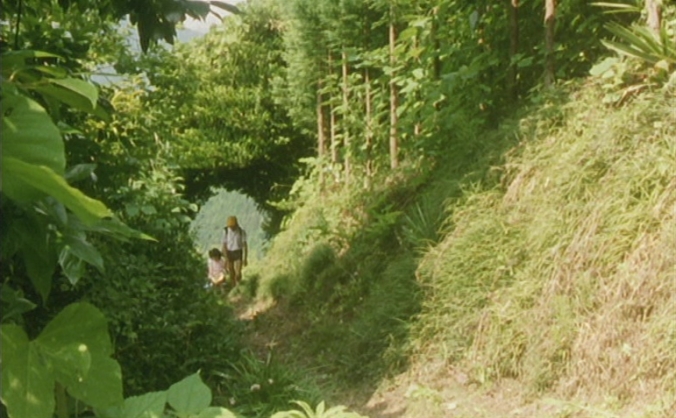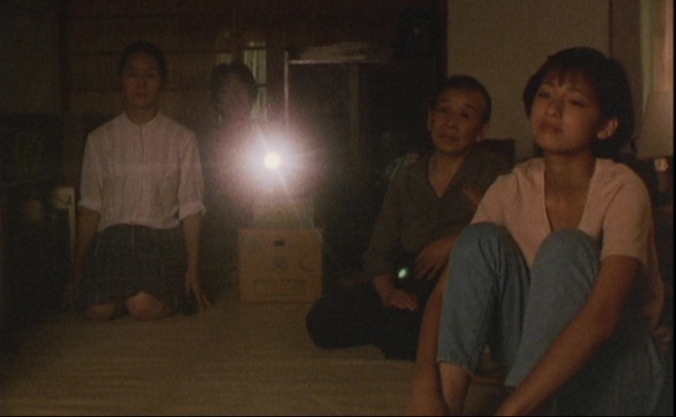 Suzaku is one of the four great constellations of Asian astronomy, generally known as the god of the south. What that has to do with the movie Suzaku is unclear, just as are most of the other major plot points in what can be seen as an signal example of a particularly Japanese kind of film-making.
Suzaku is one of the four great constellations of Asian astronomy, generally known as the god of the south. What that has to do with the movie Suzaku is unclear, just as are most of the other major plot points in what can be seen as an signal example of a particularly Japanese kind of film-making.
We open on a family in rural Japan, making breakfast. There is a grandmother, her son Kojo and his wife Yasuyo and two children. We eventually learn that Michiru, the three year old, is the family daughter while Eisuke, about eleven and on his way to school, is actually the son of Kojo’s older sister who has sent him to her mother after going to Osaka and has not been heard from again. They live in the mountains, but it is lushly idyllic, the scenery as green as in any other Japanese movie I can recall. Then we go to breakfast fifteen years later, where Michiru now in high school has a crush on her uncle Eisuke, who gives her a ride on his motorcycle to and from her bus stop on his way to work at a resort hotel.
Yasuyo, who by this time has a suspicious cough, takes a part-time job at the same hotel but collapses one day at work. Kojo sits up with her through the night but, contrary to our expectations, she does not die. Instead, Kojo goes for a walk and never returns. His body is found elsewhere without explanation, presumably a suicide. Yasuyo decides to go home to her mother, and Michiru decides to go with her, while Grandma will move to a place she will share with Eisuke nearer to his hotel job.
We are given no clear dates for either section of the movie, only that Kojo and his sister were both born sometime in the war years and that in the later segment the family has a TV and Kojo has an 8mm camera and projector. Nor are we told the place, though this is probably in the Nara area, since most of writer/director Naomi Kawase’s movies dealt with life there. This area is mountainous but, with its position on the Kii peninsula, is almost tropical in its climate, making the land both very difficult to farm yet so green we are not even sure of the seasons we see. The only big city mentioned is Osaka, which is both near and very far away, which is one of the difficulties facing the village as its young move away and population declines. Though there is bus service, the village council had placed some hope in a railway extension that would be easier for both residents and tourists to travel there, but the extension is canceled despite a tunnel for it having already been built. This mirrors the hope for a new road we saw in Himatsuri, set much closer to the coast on the same peninsula, which depicted similar declines in rural population.
As in Maborosi,
we are given no hints of Kojo’s depression nor given any explanation of the suicide itself. In the very dim light as he sits with his sick wife, we just manage to see a tear on his cheek. When the kids were young Kojo took them through the long tunnel, and when last seen he is standing before the wooden gates that have now blocked off the tunnel. Similarly, Yasuyo’s grief is expressed in a silent daze, walking pointlessly without responding to Eisuke’s calls, but he manages to lead her home through the rain.
This is not the world of Narayama where the old are sacrificed so the young can survive the poverty. There is a modest prosperity provided by the land, but nevertheless, the young leave and the village population shrinks. The village’s economic savior is more contact with the outside world, but it is contact with the outside world that keeps drawing people away.
But all that makes it sound like a sociological tract, when it is a movie about people and a place. It is just that, being traditional Japanese villagers, the people don’t unload themselves in front of the camera. We piece the story together as it goes, given only hints, and even then still don’t know what lies underneath. The family eventually watch the film in Kojo’s camera, but it does not explain his suicide;  we see only close-ups of plants and trees and faces of the other people of the village posing for him. The rest of the movie is not much different, with its camera work restrained, often with what seems to be available light, and with much attention to the scenery.
we see only close-ups of plants and trees and faces of the other people of the village posing for him. The rest of the movie is not much different, with its camera work restrained, often with what seems to be available light, and with much attention to the scenery.
Suzaku was Kawase’s first fiction film, though she had made and would continue to make some noted documentaries as well. Her camera d’or award at Cannes marks her as the first significant female movie-maker in Japan since Kinuyo Tanaka and she has continued to write and direct into the present, one of the very few Japanese women behind the camera. There is not a particularly “female” vision on display but rather an expression of a long tradition of quiet movies about “life as it is” that places her with such contemporaries as Jun Ichikawa or Kore’eda and stretches back through Yamada’s village movies to Naruse and Ozu and Shimizu, with all the drama that Euro/Americans would show occurring off camera and often without explication. It is a fine example of a persistent and uniquely Japanese way of using movies to portray real life.



Pingback: Mourning Forest / Mogari no mori (2007) | Japanonfilm